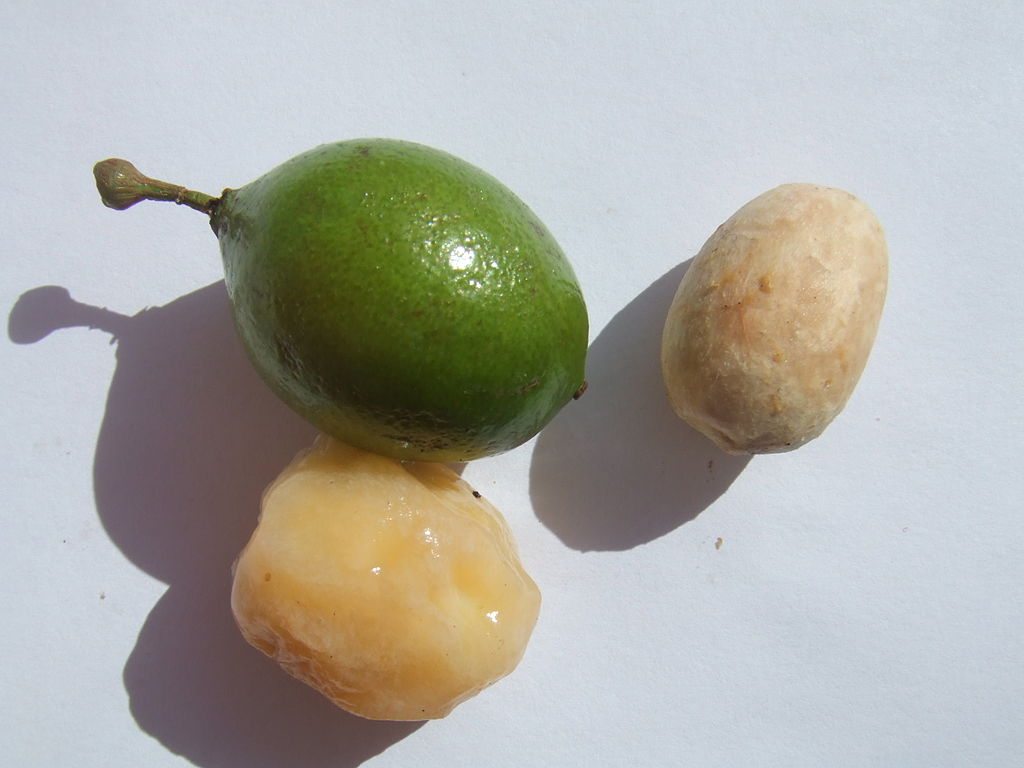[Editor’s note: We welcome back to the blog Abby Campbell, a practicing MD, Ph.D and contributor at HealthyButSmart.com, for her second post. If you haven’t already, have a look at her post on the non-wonder-drug phenibut!]

The fruit, flesh, and seed, of a quenepa.
If we are to believe certain “natural health” authorities (not mentioning any names except Natural News), a weird fruit called quenepa ( Melicoccus bijugatus Jacq.) is the latest superfood.
Yet unsurprisingly, the claims about it don’t stand up to scrutiny.
Let’s take a look at the claims and the relevant research.
What is quenepa?
Quenepa is the fruit of a tree which is native to South America. It is also known as the Spanish lime, but not spinach lime as a recent blogger said!
Quenepa is related to other exotic fruits such as longans, lychees and rambutans.
The quenepa fruit is made up of three distinct parts: green leathery skin, a pink colored fleshy pulp and a crustaceous seed coat which contains the embryo.
Each part has its own characteristics and uses. The pulp of the fruit is used to make cold drinks, deserts and jams while the seeds can be roasted and eaten like chestnuts or made into flour.
According to published papers, it has an odd taste which is part sweet and part astringent and is not to everyone’s liking. (Full disclosure, I have no idea what quenepa tastes like. Being super diligent, I did call in to my exotic local fruit shop and asked for some quenepa. All I got was a raised eyebrow and ‘You gotta be kidding me’ from the owner!)
A handful of studies (linked in the next section) have looked at the composition of quenepa and all agree that the content of the quenepa varies from country to country. So, we can say that not all quenepas are created equal! But what does quenepa do?
Does quenepa help insomnia?
Some health bloggers have claimed that quenepa is a great cure for insomnia. FYI- these are the same bloggers who called it the spinach lime not the Spanish lime! Now here is the interesting thing. There are a grand total of three papers published on quenepa! Yes three!
Being somewhere on the spectrum between geekie and obsessive compulsive, I sat down to read all three papers. The papers were actually really interesting (for geeks with OCD types).
According to the papers, quenepa is used in traditional medicine for a wide range of medical conditions including diarrhea, intestinal parasites, asthma, and hypertension, but there was no mention of insomnia.
According to health bloggers, quenepa contains tryptophan which is supposed to account for the ‘sleep benefits’. The three published studies used a technology called mass spectrometry to determine the chemical composition of quenepa.
The studies mention all sorts of weird organic acids with really complicated names but they do not mention tryptophan. Not once. Not anywhere.
To satisfy my geekiness, I emailed the lead author on all three of the quenepa papers to ask about the tryptophan connection. Lori Bystrom wrote back to me and said that she too had seen the blog referring to insomnia and tryptophan but could find no evidence to support the claim.
To summarize, quenepa is not used in traditional medicine for sleep nor do the existing studies say that quenepa contains tryptophan. Quite frankly, there is no quenepa sleep connection at all. Forget for a moment the fact that there are lots of other sleep aids that taste better and are easier to find.
Does quenepa help cholesterol levels?
There is no research to back up the claim that quenepa helps lower cholesterol.
Quenepa belongs to the Sapindaceae family and contains saponins. From other work, we know that saponins may help lower cholesterol. But before you go out and eat a tree full of quenepa, beware. Saponins are toxic to fish and can be toxic to human red blood cells if taken in high enough quantities. You have to get the dose just right. From the published work, it would be difficult to strike a balance between having enough quenepa to make a clinically significant difference to cholesterol levels while not running the risk of toxicity. Not to mention the fact that the saponin level would vary among different cultivars.
I think I will stick to watching my diet and add in a little extra exercise to keep my cholesterol in check, thank you very much.
Does quenepa help kidney stones? Urinary tract infections?
There is some evidence to suggest that citrates play a role in preventing recurrent urinary tract infections and kidney stones.
Quenepa is a source of citric acid. But to use this and extrapolate that quenepa prevents kidney infections or kidney stones is beyond irresponsible.
Further, Lori Bystrom summarizes the not-at-all-proven-but-vaguely-possible health benefits of quenepa in one of her papers and kidney stones and kidney infections are not even on the list.
Does quenepa do anything?
So what does quenepa actually do? It is used in foods and drinks but has no proven health benefits.
And there is more. The one and only paper on the possible health benefits of quenepa warns that ‘the fruit pulp may have toxicological effects when consumed excessively or during periods of growth or high iron requirements’.
So let’s look at the unique selling proposition of the quenepa fruit. It has a bitter taste, no health benefits, possible side effects, and is not readily accessible in many countries. Need I say more?
Conclusion: Not worth the carbon
Even though I am pretty eco-friendly, I do love a few foods that come with an unreasonable number of food miles. Maybe the fact that fruits, herbs and spices come from the rainforest or other exotic places makes me feel better about living in concrete suburbia.
However, I have to agree with my greengrocer on this one. There is not a single good reason to leave a massive carbon footprint to make quenepa go global!
